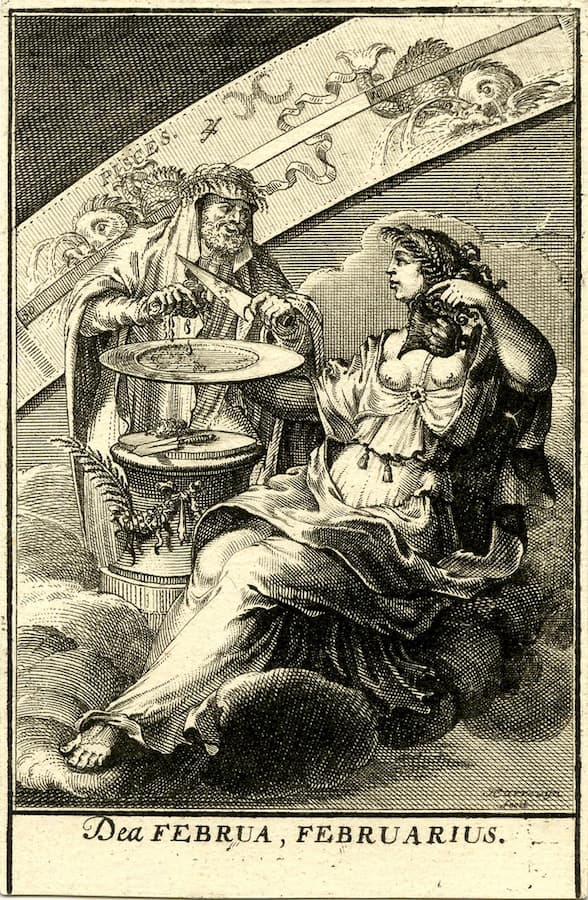Since several millennia, February, or these weeks of the year, has always been special. Among Romans, there were many festivities which took part in these days, and were deeply linked with the concept of rebirth or purification. It’s always fascinating, for me at least, to imagine how Winter and Spring could be seen from people from thousands of years ago. Let’s try digging into some ancient gods and celebrations of the past.
Fever All Through the Night #
Romans inherited deities from a few civilizations; the most famous are the counterparts from Greek mythology. Etruscans, though, who had lived in Italy centuries before, passed them Februus, an ancient god of purification; he was also linked to the underworld. In the Roman pantheon, he became Febris, a goddess1 with pretty much the same traits. She protected the people from fever, which could have been malaria; the festivities dedicated to her had a purifying function, just as one sweats when recovering from a fever.

An engraving depicting Febris, XVI Century (via Wikimedia Commons).
Febris was well-known in many parts of the Empire, and often mentioned with her daughers Tertiana and Quartana: inscriptions from the third century AD naming Tertiana were found even in Habitancum fort, in Northern England. Then, in colder regions, people were devoted to her.
It may be clear that the name of February (Februarius) comes from this goddess, and that during this month her main celebration took place. Anyway, things are a bit more complicated.
Lupercus was a protector of wild animals and of flocks, so he was worshiped by shepherds. There were many common traits with Faunus, which means that they could be the same entity. Both, for example, were deeply linked with fertility. This also explains why, lately, he had been figured as a faun, just like Pan, who was… yeah, quite a sex addict.
So, Lupercalia was the celebration of Lupercus… but of Febris, too. From the 13th to the 15th of February, a peculiar festival was taken: first, goats or sheep were offered; then two Luperci, the “priests” of this festivity, were initiated. Their foreheads were anointed with the goat’s blood, still on the sacrificial knife, and then it was washed away with a cloth soaked in milk.2 Then, the two of them had to run, half-naked, round the Palatine hill. They held stripes of goat-skin, and they hit the floor with it in order to draw an invisible wall to keep out sickness and evil spirits.
That had to be quite a party.
Drops of Jupiter #
As often always happens, these festivities had been Christianized.
Saint Febronia’s day, despite the clear name, was moved to the 25th of June. Why June?
They didn’t even put an effort on — wait.
Could make it any sense?
Well, actually yes.
Juno was the Roman goddess of childbirth. Does her name sound a little suspicious? Indeed. Was one of her main festivals taken at the beginning of… February? Yes! It was Juno Sospita.
From Wikipedia:
It was an appropriate date for her celebration since the month of February was considered a perilous time of passage, the cosmic year then coming to an end and the limits between the world of the living and the underworld being no longer safely defined. Hence the community invoked the protection (tutela) of the warlike Juno Sospita, “The Saviour”.
So, the names Februata, Februalis Februa, and Februlis referred to Juno, not Febris. The goddess purified the puerpera, the new mother, by letting the placenta out after the baby.3

A goddess called Februa did not exist. Could that be Juno, instead? Maybe.
It is important to take a moment to clear one thing: in ancient times, to be new mothers was rough. Not only because of the lack of medical help and hygiene; there was a lot of superstition towards the women who gave birth. There have always been weird rites of passage for them, all around the world.
Since the fourth century BC, among Jewish people, the woman was believed to be impure until the baby was presented to the temple. That had to happen after twenty days from the birth, in case of male babies. Forty days in case of females — weird, women were never seen as impure in more recent times.
Which day falls exactly forty days before the 2nd of February? Yes, Christmas. But… shouldn’t be Jesus a female, if he was brought at the temple after forty days?

To make it simple, Candlemas was established in this day in order to follow the original Juno’s feast. It was very typical: old traditions acquired, then made their own. We can say that the Christianity invented the EEE tactic: Embrace, Extend, Extinguish.
After all this confusion, there is one certainty, one thing that remained steadily on February: Valentine’s Day, on the 14th. Why was this claimed the day of love? Because… love is a fever. Simple as that.
-
It’s unusual that a male god was transformed in a female; typically it was the opposite. ↩︎
-
That ritual could have the meaning of death and rebirth. Remember that Februus was linked to the underworld? ↩︎
-
Still confused? Wait until you hear about Juno Februata – the ultimate combo! ↩︎